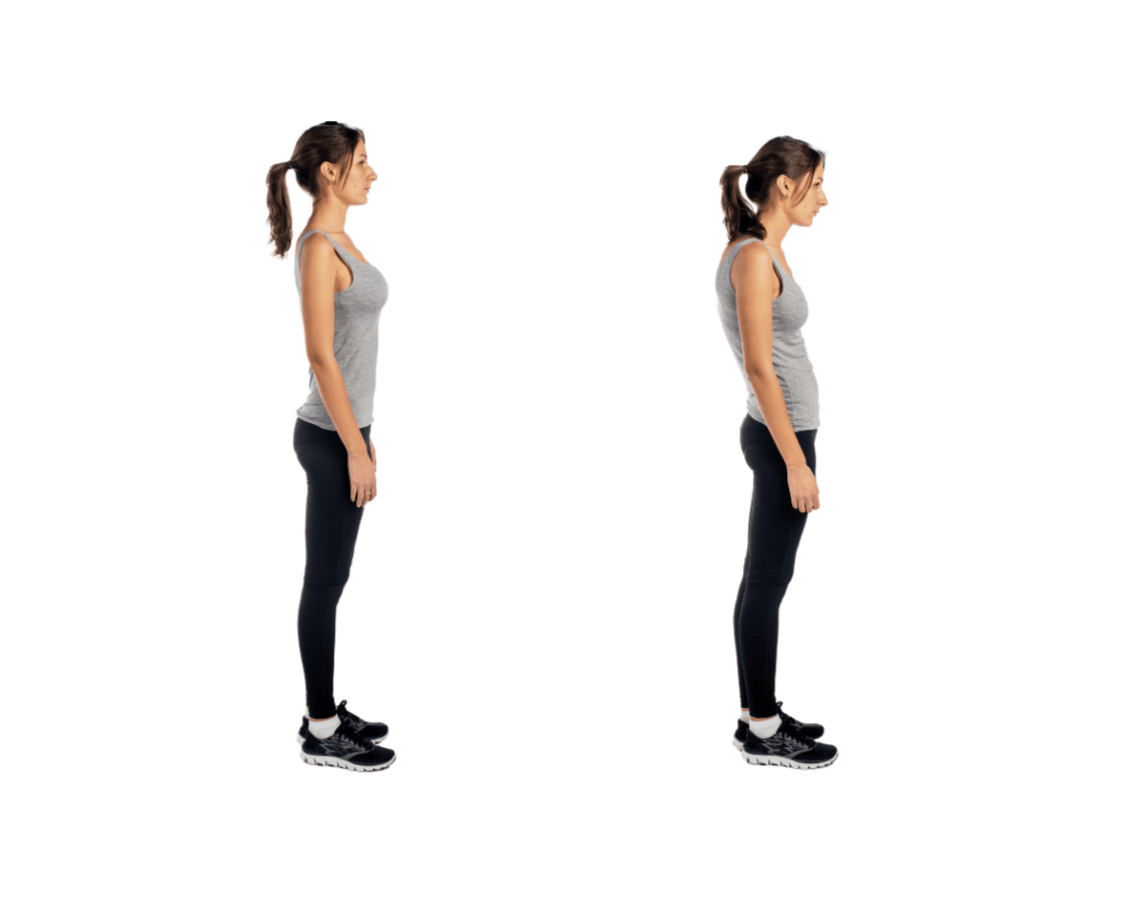Poor posture (also referred to as ‘bad posture’) is something that many of us don’t give much thought to, but it can have a significant impact on our overall health and well-being. Good posture, on the other hand, is the neutral spine alignment of the body in which the spine is in its natural position, the shoulders and shoulder blades are back, the chest is out, and the head is held high. This ‘good posture’ proper alignment allows for the balanced distribution of weight and the least amount of strain and localized muscle fatigue on the muscles and joints.
Good posture vs bad posture – how can you tell?
When assessing if someone has a correct posture or bad posture, it’s often useful to know what the difference is. Someone who exhibits correct posture with proper alignment will look upright, shoulders back and chest open, with minimal angle of the neck in relation to the upper back when viewed from the side and displaying a good separation of the ribs above the hips (indicating they have good strength in their abdominal muscles).
Poor posture is the reverse of the above-mentioned traits. When someone has that forward head posture position, rounded shoulders, increased thoracic kyphosis (rounded upper back) and sometimes even a notably large curve in the lower back or a ‘swayback posture’ presentation over a long period of time they will often suffer from several negative effects that are associated with such positioning.
What are the effects of poor posture?
Now, certain positions that are associated with poor posture are not always bad. On long journeys in a car or plane, short-duration poor posture can help relieve muscle tension and joint ache – as the body responds best to regular movement. Staying in the same position too long can cause discomfort, which is why knowing how to correct posture is important for you to be able to apply this knowledge to your own day-to-day life.
One of the most significant effects of bad posture is chronic pain. When the spine is not in neutral alignment for prolonged periods, it can cause excess strain on the muscles, joints, tendons and ligaments. This can lead to headaches, muscle fatigue, neck pain and back pain, shoulder pain and even chronic conditions resulting from decreased muscle activity such as fibromyalgia and chronic fatigue syndrome. Poor posture can also exacerbate existing conditions, such as arthritis, scoliosis, and herniated discs.
Prolonged sitting, which is becoming increasingly common today, is one of the main causes of poor posture. Sitting for prolonged periods in front of a computer or on a couch can lead to forward head positioning and rounded shoulders, which in turn can cause chronic pain and stiffness. Even if you exercise regularly, prolonged sitting can undo all the benefits of your workout.
Poor posture can also have an impact on one’s lung capacity. When the spine is in increased thoracic kyphosis (rounded shoulders and upper back) the chest is compressed and, it can make it difficult for the lungs to expand fully, leading to shallow breathing and decreased oxygenation. This can result in fatigue, shortness of breath, and even anxiety and depression.
Additionally, having poor posture for long periods can lead to a negative impact on digestion. Slouching can cause the stomach to press against the diaphragm, making it difficult for the stomach to properly digest food. This can lead to bloating, gas, and other digestive tract issues.
Poor posture can also have an impact on one’s mental health. When the body is in a forward head, slouched/hunched position, it sends a message to the brain that the person is feeling defeated or submissive. This can lead to feelings of low self-esteem and a lack of confidence.
How can you improve your posture?
So, what can be done to improve posture and reduce the negative effects it can have on health?
- Exercise and stretching: Incorporating regular exercise and stretching into your routine can help to strengthen the muscles that support the spine and improve flexibility. You can even reverse that forward head position and normalise a more ‘neutral spine’ position. This can include exercises such as yoga, Pilates, and core-strengthening exercises.
- Get checked and adjusted by your chiropractor regularly! We all know that in the rapid-paced lives that we lead that it is easy for some healthy habits to slip through the cracks when life gets too frantic and busy. This is why the reminder of your chiropractic appointments is not only tune-up for the body but a great mental tune-in on any little poor habits that may have snuck under the radar.
- Pay attention to posture: It is important to pay attention to your posture throughout the day, whether you are sitting, standing, or walking. Set reminders throughout the day to check your posture and make adjustments as necessary.
- Use ergonomic equipment and furniture: Using equipment and furniture that is designed to support the body in a neutral position can help to improve posture. This includes things like office chairs, computer monitors, and keyboard trays.
- Maintain a healthy weight: Maintaining a healthy weight can help to reduce the strain on the muscles and joints, leading to better posture.
- Sit on an exercise ball: Sitting on an exercise ball instead of a chair can also help to engage the core muscles and improve posture.
Stand-up desks: Consider using a stand-up desk, this can help to reduce the time you spend sitting and improve your posture.
Get chiropractic help for your posture
It is important to remember that improving posture is a process that takes time and effort. It may take a few weeks or even months to see significant changes, but the benefits are well worth it. By taking steps to improve posture, people can not only look better, but also feel better and reduce their risk of chronic pain, illness, and fatigue. This is why we recommend getting assessed and adjusted by your local Karrinyup Perth chiropractors at Karrinyup Wellness Centre to keep on top of your posture and maintain your spinal health.


